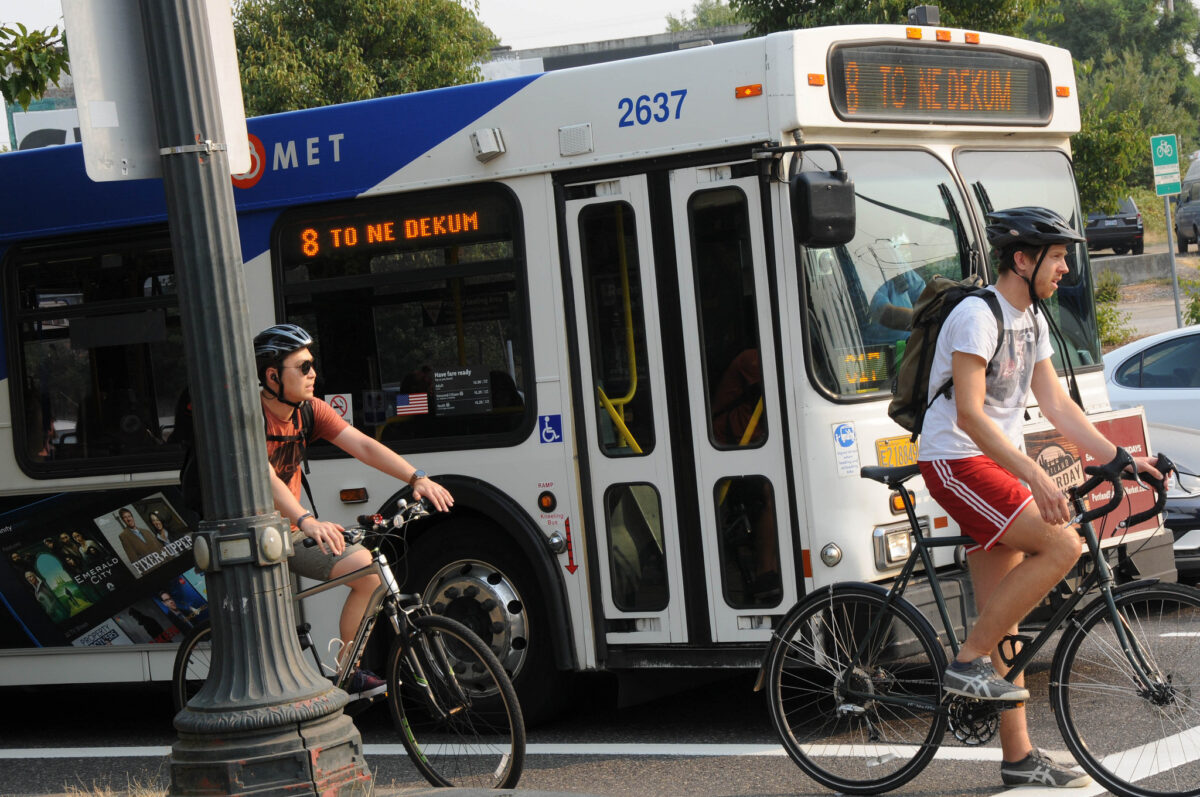
(Photo: Jonathan Maus/BikePortland)
This is crossposted from the Sightline Institute. Michael Andersen is a former BikePortland news editor.
The proposal going before Portland City Council at 2 pm today would be the city’s most important biking infrastructure investment in 20 years, and its most important bus infrastructure investment in 40.
Just as importantly, it’d also make our streets work better, permanently.
The Central City in Motion plan avoids the false promise of bigger roads: 39 percent of the central city is already dedicated to street space, it notes. So, as Jonathan reported last month, it’s planning to dedicate an additional 1 percent of those central streets to bike lanes and another 1 percent to bus lanes.
That little shift in urban space, which would take the form of 18 street projects over the next 10 years, would boost the people-moving capacity of the affected streets by an average of 60 percent.
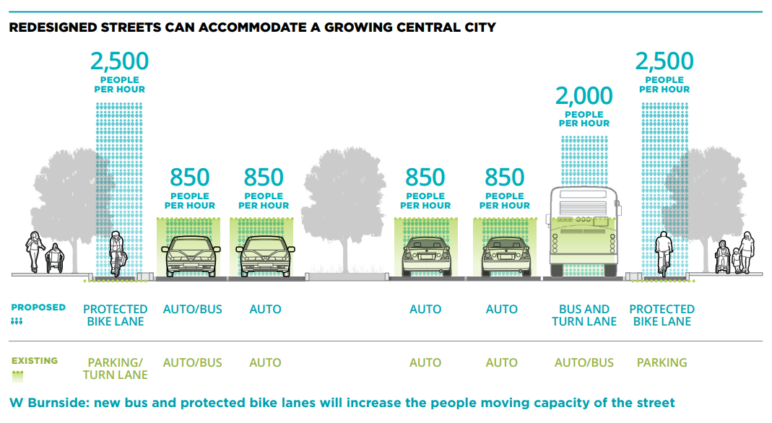
That’s based on calculations from the National Association of City Transportation Officials. Need more proof? Ask TriMet, who just revealed that relatively tiny lane tweaks led to a significant decrease in delays on several lines.
Price tag: $72 million, or about the cost of a single mile of urban freeway.
“Just like a road network or a computer network, low-stress bikeways have little value to anyone until they’re connected to other low-stress bikeways.”
It’s worth noting that boosting the potential capacity of a street isn’t the same as getting people to use that potential by riding a bike or getting on a bus. And one potential risk of Portland’s current plan is that a big part of it—a connected lattice of low-stress bike lanes on Burnside, SW Broadway, SW 4th, NE/SE 7th, SW Madison, NW 14th, NW Everett, SW Salmon, SW Taylor, SE Hawthorne, NE Multnomah, NE Lloyd, Naito Parkway, NE Broadway, and NE Weidler —might not pay off much until the entire network is finished.
Just like a road network or a computer network, low-stress bikeways have little value to anyone until they’re connected to other low-stress bikeways.
Some cities—Vancouver, BC; Calgary, Alberta; Sevilla, Spain—have recently shown the power of installing a simple protected bike lane network all at once, with relatively cheap and adjustable materials, so transportation habits can shift quickly and everyone—voters, nearby businesses, politicians themselves—can see the payoff. It’s not clear whether or not Portland is planning to learn from that example as it builds its own network.
That said, the only way a city can truly fight traffic is to better use the street space that already exists. If Portland moves this plan forward, it’ll become the latest city to show the rest of the world how to fight congestion right, and allow more people to enjoy the blessings of the city.
— Michael Andersen, Sightline Institute
Never miss a story. Sign-up for the daily BP Headlines email.
BikePortland needs your support.


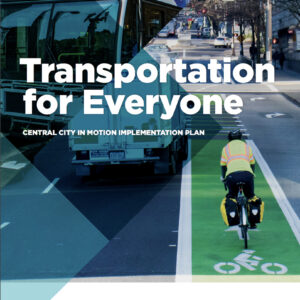
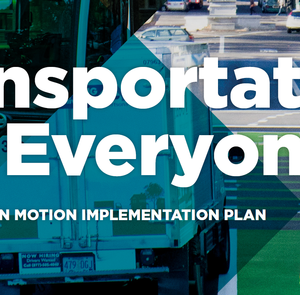
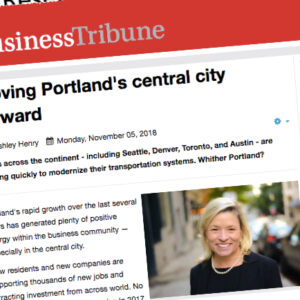

Thanks for reading.
BikePortland has served this community with independent community journalism since 2005. We rely on subscriptions from readers like you to survive. Your financial support is vital in keeping this valuable resource alive and well.
Please subscribe today to strengthen and expand our work.
To Paraphrase MLK, ” The arc of history is long, but it bends toward cycling and away from the automobile.”.
Intersectional politics?
And it’s good to see Luke Norman, once with Portland Bus Lane Project, as TriMet’s spokesperson for the first steps towards bus-only lanes.
sure is! I wanted to do a separate post on the TriMet stuff (still might)… And thrust would be how a former bus lane activist was now featured in the official TriMet video for bus lanes! A definite feel-good Portland story.
I’d love to testify, and I hope many people will, but I’ve got a Greensboro Transit Authority board meeting I’m required to attend at 6 pm EST, 3 pm normal time. We’re looking at route changes for most of our buses.
I find it hilarious that you talk like these project will actually get funded and built. Every time BikePortland has reported on this plan, there seems to be less and less money available. What is PBOT spending the money on? As it stands currently, half of the projects are unfunded. PBOT is set to spend the remainder of the money on a parking garage, leaving no money left for any of the projects in the plan. Even if PBOt does fund money, the will build as cheaply as possible, like the dangerous and half-assed 2nd Avenue protected bike lane.
This plan is the same as all of the other Portland plans and will sit on a shelf unfunded. Stop letting PBOT fool you time and time again. This publication acts as a mouthpiece for PBOT, championing every new commissioner and every new plan while neglecting to do any investigative journalism into why nothing ever gets done. Is it because the owner of this blog doesn’t want to give up his insider access? Who knows. Bottom line is that our seemingly progressive politicians are more than happy to squander your tax money on pet projects while you continue to suffer under mediocre transportation infrastructure. Don’t expect any change from our leadership. Stop letting them trick you.
I’m being nitpicky but the title needs to be adjusted to restripe 5% of street right of way. The figures in the CCIM refer to all central city right of way.
You mean you feel “roads” is inaccurate because it doesn’t include sidewalks?
I find the capacity per lane of the different modes as shown in the graphics to be highly misleading if not outright errors.
The capacity of a bicycle lane appears to be a maximum theoretical capacity without considering any disruptions associated with things like intersections. A good discussion can be found by doing a google search to find Dan Zhou’s paper presented at TRB. We can find local examples such as the Hawthorne Bridge. People complain on this forum that the Hawthorne Bridge is totally overcapacity and it’s carrying nowhere near 2500 cyclists in an hour.
In contrast, the 850 person capacity for an auto lane is clearly far less than the theoretical capacity of 1800 to 2000 vehicles per lane used in traffic engineering analyses. Presumably, the 850 persons is calculated under the assumption that intersections reduce capacity by one half due to cross traffic and that autos contain exactly one person. If you are going to consider intersections when calculating one mode’s capacity, it should be applied to others.
Likewise, bus capacity of 2000 persons per hour is pretty misleading as well. It works out to a full Trimet bus running on 1 1/2 to 2 minute intervals. That doesn’t account for boarding and deboarding.
I don’t disagree with the proposals to devote more space for users of bicycles and transit, but I don’t think our cause is helped by using questionable calculations.
I came here to say the same thing, but you did it better than I would have.
This is plan for the (far) future. They probably calculated capacity for swarming autonomous e-bikes, or for some serious packing density, swarming autonomous e-scooters.
I wish I could say they did, but I’m pretty sure they didn’t.
This strikes me as a fair critique. NACTO is a pretty data-driven and technically savvy advocacy organization, but ultimately they’re an advocacy organization, so it’s safe to assume they pushed those estimates to their maximum reasonable capacity.
Sort of agree (apples to apples would be better).
However, that capacity you describe for auto lanes is a freeway lane at high speed with unsafe headways, like one might see just off-peak in LA.
Downtown Portland streets have actually been measured moving about 850 vehicles per lane per hour (friction issues). Division near 57th has been measured moving up to 1,300 vehicles per hour one direction in the peak.
Wider bike lanes in the central city is like moving from terrible bike infrastructure to slightly less terrible bike infrastructure. If you ever ride the Stark Street bike lane you know what I am talking about. You’ve got autos parking, autos dropping people off, people driving in the bike lane because they don’t know it’s a bike lane, people crossing the bike lane to turn right, etc. It’s abysmal, and at the same time still less bad than a narrow bike lane. Is it currently safe enough that you can calmly imagine young kids or seniors riding on the Stark Street bike lane?
I’m sure everyone’s tired of hearing about it but the only potential solution I can think of is moving parking outwards and doing a protected lane next to the curb (protected by parked cars). You get a lot of people walking or hanging out in these protected bike lanes where they do exist downtown (i.e. PSU, 2nd), but I’d rather deal with people in the bike lane then get hit by autos pulling out of parking spots or moving into the bike lane to turn right.
Striping wide lanes where cars can simply swerve into you serves from the “brave” to “less brave”. But it’s not going to get people out with their kids in mass, or soccer moms or soccer dads. Sure, it makes it nice for the already dedicated. It’s very interesting to note that a city with much worse weather (Vancouver) is actually getting it done..but just a few hundred miles to the south, Portland still throws old cars out on the front lawn claiming they are the rich uncle with all the cool cars.
The 2-3 block re stripping from the Parkrose Transit center to the I-205 on ramp basically eliminated the shoulder on Sandy leaving no room for bikes attempting to make the connection back onto the I-205 MUP Northbound. This forces me onto the narrow sidewalk or I need to be brave and just take that lane. Granted there are not many bikes on that section on Sandy Blvd during the day, so the needs of the many outweighed the needs of the vulnerable. Try riding that section during rush hour, it’s certainly a challenge to avoid getting hit by impatient drivers and those trying to cut in from the side streets